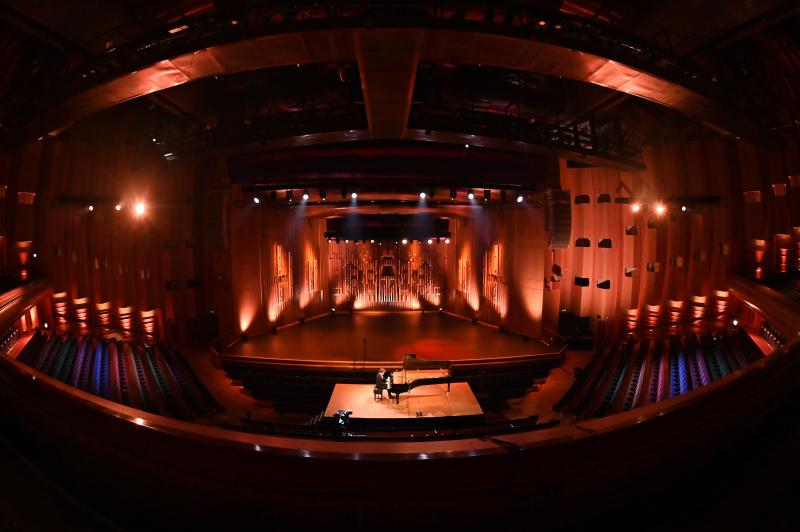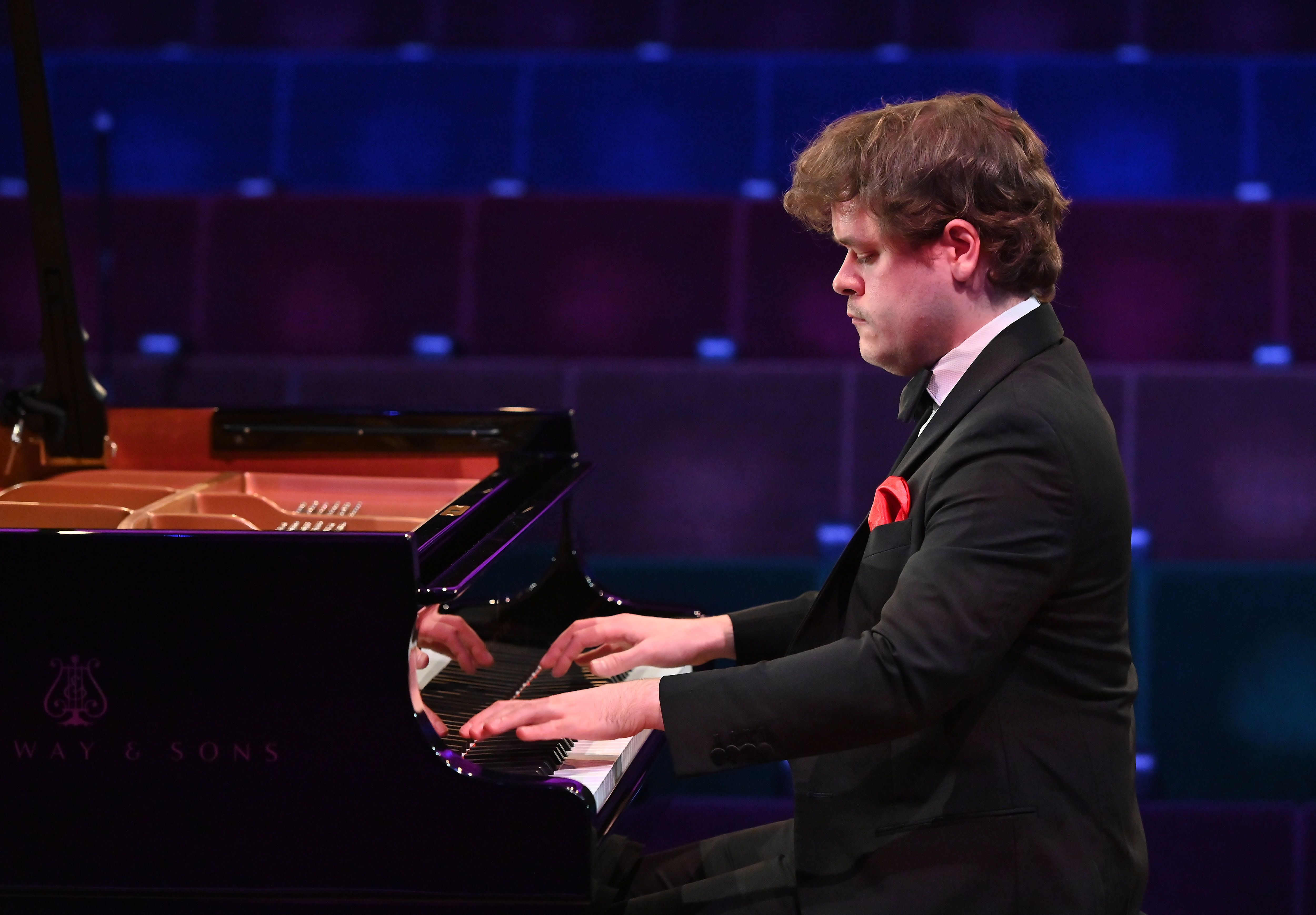Benjamin Grosvenor, Barbican online review - black magic and golden-age gorgeousness | reviews, news & interviews
Benjamin Grosvenor, Barbican online review - black magic and golden-age gorgeousness
Benjamin Grosvenor, Barbican online review - black magic and golden-age gorgeousness
The British pianist's recital beautifully evokes romanticism in isolation

I can’t deny that it’s great to be able to experience a recital by Benjamin Grosvenor live from the Barbican despite lockdown, streamed into your own home.
For his “Live from the Barbican” recital, Grosvenor chose a programme that was short, but meaty. He opened with an ideal musical prayer: Liszt’s transcription of Schubert’s Ave Maria, in which he wove a spell of the first order, garlanding the deep-set melody with Liszt’s filigree silver-lace passagework. It calmed and focused us before the drama of Chopin’s Sonata No. 3 in B minor. To this, the pianist imparted a kaleidoscope of colours, with polyphonic lines gleaming and finely chiselled, relishing the Italianate twists of melody in the first movement, the mercurial rhythmic sleight-of-hand of the scherzo and the rapt nocturnal hush in the third. The finale could perhaps have used, at times, extra darkness to enhance the contrasting brilliance, but Grosvenor's clarity of touch always captured the way Chopin can create textural effects on the piano that no orchestra could possibly match.  A complete change of character came with the third work, Ginastera’s Three Argentinian Dances – dazzling music that’s sometimes milked for its harsh virtuosity, but in which Grosvenor found lightness, swing and song besides. Nevertheless, the high point of the programme was Ravel’s Gaspard de la Nuit: three fantastical pieces that positively ooze black magic. Here Grosvenor’s sensitivity and refulgence of tone paid dividends from start to finish. If anything, as in the Chopin sonata, one wished occasionally for greater abandonment to the mystery and horror that lurks behind these sound-pictures: the wildness of the water-nymph Ondine, the gallows and its victim at sunset, and the demoniac "Scarbo" – but perhaps that is something to look forward to at some future event when the place is packed with listeners to induce the impulse for that one extra mile. Grosvenor added an encore, Saint-Saëns’s "The Swan" in the transcription by Leopold Godowsky: the sort of golden-age gorgeousness in which Grosvenor’s reinvented golden-age pianism is utterly at home.
A complete change of character came with the third work, Ginastera’s Three Argentinian Dances – dazzling music that’s sometimes milked for its harsh virtuosity, but in which Grosvenor found lightness, swing and song besides. Nevertheless, the high point of the programme was Ravel’s Gaspard de la Nuit: three fantastical pieces that positively ooze black magic. Here Grosvenor’s sensitivity and refulgence of tone paid dividends from start to finish. If anything, as in the Chopin sonata, one wished occasionally for greater abandonment to the mystery and horror that lurks behind these sound-pictures: the wildness of the water-nymph Ondine, the gallows and its victim at sunset, and the demoniac "Scarbo" – but perhaps that is something to look forward to at some future event when the place is packed with listeners to induce the impulse for that one extra mile. Grosvenor added an encore, Saint-Saëns’s "The Swan" in the transcription by Leopold Godowsky: the sort of golden-age gorgeousness in which Grosvenor’s reinvented golden-age pianism is utterly at home.
If “vaccine passports” are what it takes to get people back into concert halls to share the music with the performers and with one another, then bring it on, the sooner the better. Grosvenor managed the situation well, and he is one of those musicians who must by now be getting used to the artificiality of it, but in general there is nothing that damages the essence of music-making, which is communication, quite like the palpable absence of anyone to communicate with.
rating
Explore topics
Share this article
The future of Arts Journalism
You can stop theartsdesk.com closing!
We urgently need financing to survive. Our fundraising drive has thus far raised £49,000 but we need to reach £100,000 or we will be forced to close. Please contribute here: https://gofund.me/c3f6033d
And if you can forward this information to anyone who might assist, we’d be grateful.

Subscribe to theartsdesk.com
Thank you for continuing to read our work on theartsdesk.com. For unlimited access to every article in its entirety, including our archive of more than 15,000 pieces, we're asking for £5 per month or £40 per year. We feel it's a very good deal, and hope you do too.
To take a subscription now simply click here.
And if you're looking for that extra gift for a friend or family member, why not treat them to a theartsdesk.com gift subscription?
more Classical music
 Appl, Levickis, Wigmore Hall review - fun to the fore in cabaret and show songs
A relaxed evening of light-hearted fare, with the accordion offering unusual colours
Appl, Levickis, Wigmore Hall review - fun to the fore in cabaret and show songs
A relaxed evening of light-hearted fare, with the accordion offering unusual colours
 Lammermuir Festival 2025, Part 2 review - from the soaringly sublime to the zoologically ridiculous
Bigger than ever, and the quality remains astonishingly high
Lammermuir Festival 2025, Part 2 review - from the soaringly sublime to the zoologically ridiculous
Bigger than ever, and the quality remains astonishingly high
 BBC Proms: Ehnes, Sinfonia of London, Wilson review - aspects of love
Sensuous Ravel, and bittersweet Bernstein, on an amorous evening
BBC Proms: Ehnes, Sinfonia of London, Wilson review - aspects of love
Sensuous Ravel, and bittersweet Bernstein, on an amorous evening
 Presteigne Festival 2025 review - new music is centre stage in the Welsh Marches
Music by 30 living composers, with Eleanor Alberga topping the bill
Presteigne Festival 2025 review - new music is centre stage in the Welsh Marches
Music by 30 living composers, with Eleanor Alberga topping the bill
 Lammermuir Festival 2025 review - music with soul from the heart of East Lothian
Baroque splendour, and chamber-ensemble drama, amid history-haunted lands
Lammermuir Festival 2025 review - music with soul from the heart of East Lothian
Baroque splendour, and chamber-ensemble drama, amid history-haunted lands
 BBC Proms: Steinbacher, RPO, Petrenko / Sternath, BBCSO, Oramo review - double-bill mixed bag
Young pianist shines in Grieg but Bliss’s portentous cantata disappoints
BBC Proms: Steinbacher, RPO, Petrenko / Sternath, BBCSO, Oramo review - double-bill mixed bag
Young pianist shines in Grieg but Bliss’s portentous cantata disappoints
 theartsdesk at the Lahti Sibelius Festival - early epics by the Finnish master in context
Finnish heroes meet their Austro-German counterparts in breathtaking interpretations
theartsdesk at the Lahti Sibelius Festival - early epics by the Finnish master in context
Finnish heroes meet their Austro-German counterparts in breathtaking interpretations
 Classical CDs: Sleigh rides, pancakes and cigars
Two big boxes, plus new music for brass and a pair of clarinet concertos
Classical CDs: Sleigh rides, pancakes and cigars
Two big boxes, plus new music for brass and a pair of clarinet concertos
 Waley-Cohen, Manchester Camerata, Pether, Whitworth Art Gallery, Manchester review - premiere of no ordinary violin concerto
Images of maternal care inspired by Hepworth and played in a gallery setting
Waley-Cohen, Manchester Camerata, Pether, Whitworth Art Gallery, Manchester review - premiere of no ordinary violin concerto
Images of maternal care inspired by Hepworth and played in a gallery setting
 BBC Proms: Barruk, Norwegian Chamber Orchestra, Kuusisto review - vague incantations, precise laments
First-half mix of Sámi songs and string things falters, but Shostakovich scours the soul
BBC Proms: Barruk, Norwegian Chamber Orchestra, Kuusisto review - vague incantations, precise laments
First-half mix of Sámi songs and string things falters, but Shostakovich scours the soul
 BBC Proms: Alexander’s Feast, Irish Baroque Orchestra, Whelan review - rapturous Handel fills the space
Pure joy, with a touch of introspection, from a great ensemble and three superb soloists
BBC Proms: Alexander’s Feast, Irish Baroque Orchestra, Whelan review - rapturous Handel fills the space
Pure joy, with a touch of introspection, from a great ensemble and three superb soloists
 BBC Proms: Moore, LSO, Bancroft review - the freshness of morning wind and brass
English concert band music...and an outlier
BBC Proms: Moore, LSO, Bancroft review - the freshness of morning wind and brass
English concert band music...and an outlier

Add comment